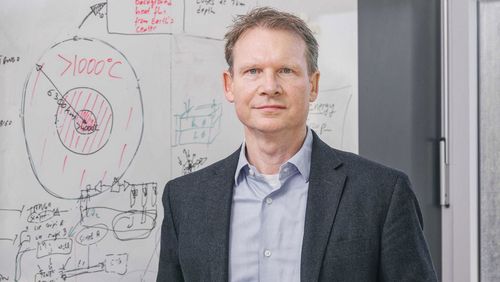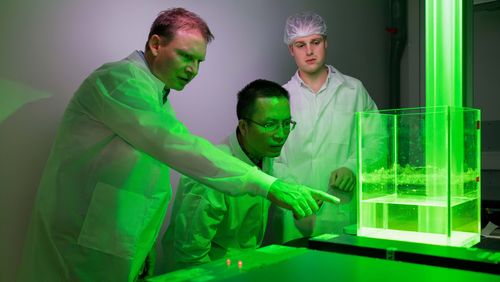Earthquakes on low heat
Generating electricity from geothermal energy—a technology Switzerland has yet to capitalize on, although the US has long profited from this energy source. Martin O. Saar, professor of geothermal energy at ETH Zurich, tells us how and why.
In Switzerland, hardly a new home or residential building is constructed without a geothermal heat pump being installed. So, why do we still need research into geothermal energy?
Martin O. Saar: In geothermal research, we differentiate between superficial geothermal energy for heating and deep geothermal energy for generating electricity. When we talk about heat pumps, we’re referring to geothermal energy close to the Earth’s surface. No electricity is generated via the heat pumps; instead, they absorb solar heat that is stored in the Earth. They are a special case of geothermal energy, but one that is very important in Switzerland for heating homes—and, by the way, to cool them in southern climates.
What is the current status of using deep geothermal energy in Germany and Switzerland?
Switzerland, specifically its federal government, has only very recently begun to invest heavily in deep geothermal energy. The country’s planned nuclear phase-out and the so-called “energy transformation” have increased the pressure to use alternative sources of energy. In Germany, use of geothermal energy is already much more advanced. This is partly due to the slightly better geological conditions, but partly because underground research and mining has a very long tradition in Germany. Much more is known about subterranean conditions, especially way down deep. Another—not incidental—reason is the federalist system in Switzerland, where the 26 cantons often have their own highly specific regulations on accessing underground resources. This makes it difficult for companies and investors alike to establish and advance a geothermal project. As a result, Switzerland hasn’t yet begun to use geothermal energy to generate electricity.
In Basel and St. Gallen, the experiments on generating electricity in geothermal power plants had to be discontinued due to earth tremors. What went wrong?
In Basel, relatively large amounts of fluid were injected into the ground, which triggered an earthquake. Although it was just a minor quake, it unfortunately caused damage above ground. When fluid is injected underground, we expect earthquakes to occur; the critical part is ensuring they remain very small.
A geothermal power plant is currently being planned in the Jura region. Has research progressed far enough to be sure that the technology is safe?
In Haute-Sorne, a petrothermal power plant is envisioned that would inject water into the underground. But it isn’t yet clear that it will be built. It’s precisely because the trial-and-error method used in Basel and St. Gallen should be avoided that my professorship—and others throughout Switzerland—were created. At the moment, we’re collaborating with the “Swiss Competence Center for Energy Research—Supply of Electricity” to ensure that these petrothermal systems don’t trigger large earthquakes in future.
How can you do that? How can you test the right dosage for an earthquake?
To learn more, we conducted an experiment in the Grimsel rock laboratory, in the Nagra tunnel; the data are currently being interpreted and should provide answers. The next underground experiment is scheduled to take place in the now defunct Bedretto arm of the Furka Base Tunnel, where we can go even deeper than the 500 metres we managed in the Grimsel rock lab: one to one-and-a-half kilometres below the Earth’s surface.
In the scope of its energy transition goals, Switzerland aims to cover 12% of its energy demand using renewable energies, and this starting 2035. It’s estimated that a dozen geothermal energy plants will have to be generating electricity by then. Is this goal realistic?
It will be extremely difficult. Right now, we don't even know whether we’ll manage one plant. But a lot of prior research was also needed before nuclear energy could be used. Although petrothermal systems have been researched since the seventies—first in the US—intense work has been seen only in the past ten years. And in Switzerland, it’s only been four years, not counting the experiments in Basel and St. Gallen.
Before you took on the professorship for geothermal energy at ETH Zurich, you were professor at the University of Minnesota in the US. Does the research on geothermal energy conducted there still factor into your work?
I earned my master's degree and PhD in the US and was professor there for ten years. I still lead a small research group in the US, and I co-founded a geothermal energy company. As such, I have close contact and continue to collaborate in American research projects. The US is a global leader in geothermal power plants that have a capacity of over three gigawatt. But it should be noted that this corresponds to three large coal-fired power plants—a negligible amount compared to the over 600 coal plants in the country.
Is there a reason there are so few geothermal power plants?
Well, it's difficult to convey large amounts of geothermal energy to the surface. In the US, most geothermal power plants are located in California and Nevada where the geological conditions are better. High subsoil temperatures are quite near the Earth’s surface and seismic activity is relatively high. Most areas, Switzerland included, don’t offer these advantages. Through our research, we aim to access geothermal energy in areas that, up to now, weren’t suitable for generating electricity.
Interview: Sabine Witt
Photos: Felix Wey








